Gopher Tortoise testing of Torreya seed dispersal
Summary by Connie Barlow, July 2020:
2015 EXPERIMENT LAUNCHED by Jason Richardson, PhD Student, Department of Integrative Biology, University of South Florida. Feb 3, 2015, Jason Richardson wrote to Lee Barnes:
... I would like a pack of seeds. I assume Connie or Jack had me added to this list. If you are unfamiliar, I am a PhD student at the University of South Florida. For my dissertation, I am examining the effects gopher tortoises have on plant community composition, and also how they affect germination of seeds in their diet. I am particularly interested in how they may enhance germination of rare and endangered plant seeds, and if they may be used in conservation efforts for such plants, and thus I emailed the Torreya Guardians about obtaining seeds." February 9: "I will be quantitatively testing germination rate and percentage as well as qualitatively examining the seed coat structure via electron microscopy. These two methods will be done both for ingested and non ingested seeds. I had not considered the stratification effects, could I get a pack of 20 of both stratified and non? More is always better for statistical analyses, but I think this will be a good start to see where it leads."
Note by Barlow: Lee Barnes sent Jason seeds from the 2014 harvest, but they were already cleaned of the fleshy covering that would be what tortoises are interested in. Jack Johnston sent seeds with green flesh in 2015.
2020 REPORT OF RESULTS by Jason Richardson via email to Connie Barlow. July 21, 2020, Jason Richardson wrote to Connie Barlow:
"Seeds were unable to be consumed by gopher tortoises (too large). Any possible chelonian seed disperser is probably extinct. Seeds were fed to a sulcata tortoise at Zoo Tampa. Some were crushed but we did manage to collect a good number of them passed seemingly intact. I unfortunately had no germination success for these seeds, nor for the unpassed seeds. I have since graduated and am no longer working in science. If you are interested I can give you some other researchers who may be interested in trying to replicate or further this work."
Supplemental information by Connie Barlow: (1) Because Torreya seeds usually require 2 winters of cold stratification before germinating, it is possible that less time and/or insufficient cold were available for study prior to the need to publish results. (2) Richardson's PhD thesis can be found in full here; torreya seed experiments are not mentioned in it, however, "Seeds from the two fleshy-fruited species, O. humifosa and P. angustifolia, germinated in significantly greater proportions and faster after gut passage than seeds that did not pass through the gut." (3) Wikipedia entry on Sulcata Tortoise: "The African spurred tortoise (Centrochelys sulcata), also called the sulcata tortoise, is a species of tortoise, which inhabits the southern edge of the Sahara desert, in Africa. It is the third-largest species of tortoise in the world, the largest species of mainland tortoise, and the only extant species in the genus Centrochelys."
• The Florida Torreya and the Atlanta Botanical Garden, by David Ruland, in Conifer Quarterly, pp. 10-14 (2007). Note: As of 2019, David Ruland is Greenhouse Manager for Atlanta Botanical Garden.
... According to fossil records, the Florida torreya is estimated to be over 165 million years old. Like many other conifers with such an impressive age, it was once scattered throughout the northern hemisphere. Scientists theorize the species was driven south by glaciers that once covered the northern latitudes. When the glaciers retreated, the Florida torreya was left isolated in small microhabitats of the southeastern United States, where it thrived for thousands of years.
... Many of the original Arnold Arboretum cuttings have matured into cone and seed producing trees [at Atlanta Botanical Garden] that, in total, form over 500 viable seeds per year on average. These plants are grown in the ABG "seed orchard" and propagules produced from these seeds have been used to facilitate the next phase in the recovery of this species.
... In 2002 ABG initiated a collaborative project with Florida State Park Service that involved reintroduction of seedlings into ravines at Torreya State Park (TSP), where Torreya taxifolia has been extirpated.... Great efforts are made to ensure that introduced plants are not planted in ravines where existing plants occur. The plants are bare-rooted prior to placing in the native soil. Four treatments are used on the outplanting: fungicide, fertilizer only, fertilizer and lime, and control. These experimental transplants will help determine the optimal treatment, if any, that is needed for future success reintroducing this species. A total of 200 seedlings have been outplanted in TSP and the survival rates so far are encouraging.
... Despite the successes of the conservation program, the Florida torreya faces a long road ahead to recovery. Even if wild populations were capable of producing viable seed, the Florida torreya would seem incapable of expanding its limited range due to a lack of a natural dispersal agent. The aforementioned squirrel has proven to be capable of seed dispersal but almost certainly is not the original prime disperser. It was most likely a large extinct animal, although speculation on such matters in the plant world is endless.
... The concern over the Florida torreya's inability to reclaim its former habitats has given rise to a movement among conservationists called "assisted migration." The basic idea is to see populations of T. taxifolia moved further north into more hospitable climates. It would be encouraged to integrate naturally, thereby securing the tree in the wild again. Torreya taxifolia does thrive in areas such as Asheville, North Carolina and even much further north. Indeed, as is the case with many types of plants, the cool night / warm day temperature differential would seem to be conducive to a healthier tree. The Atlanta Botanical Garden is not a proponent of such measures. It is prudent to establish safe-guarded populations in cooler climates within the confines of cultivated or human disturbed areas, not in pristine natural habitats. Therefore these plants can be further evaluated in a botanical garden setting and seed development encouraged without creating further ecological disturbance.
The Florida torreya is a glacial relic, seemingly stranded in an increasingly hostile niche without any natural means of escape or survival. This tree would certainly be doomed without the intercession of concerned individuals and institutions....
• October 2019 / Connie Barlow / VIDEO by Tallahassee Public TV station on Hurricane Michael Damage
Six-minute video titled Torreya State Park After Hurricane Michael: One Year Later was produced by WFSU, the public TV station affiliated with Florida State University in Tallahassee. The video begins with a look at the two unlikely survivors of the hurricane where the entrance road ends in a parking lot. Both Gregory House and a planted little grove of torreya trees at the lawn edge survived, the tall trees fallen all around them.
For viewers and readers familiar with the paleoecological foundation undergirding the drive for "assisted migration" poleward of the glacial relict Torreya tree, the video offers a few hints of the steephead ravine ecosystem similarities in the park to habitats now found in the southern Appalachians. The actions of Torreya Guardians are of course not mentioned. But the accompanying essay does say this:
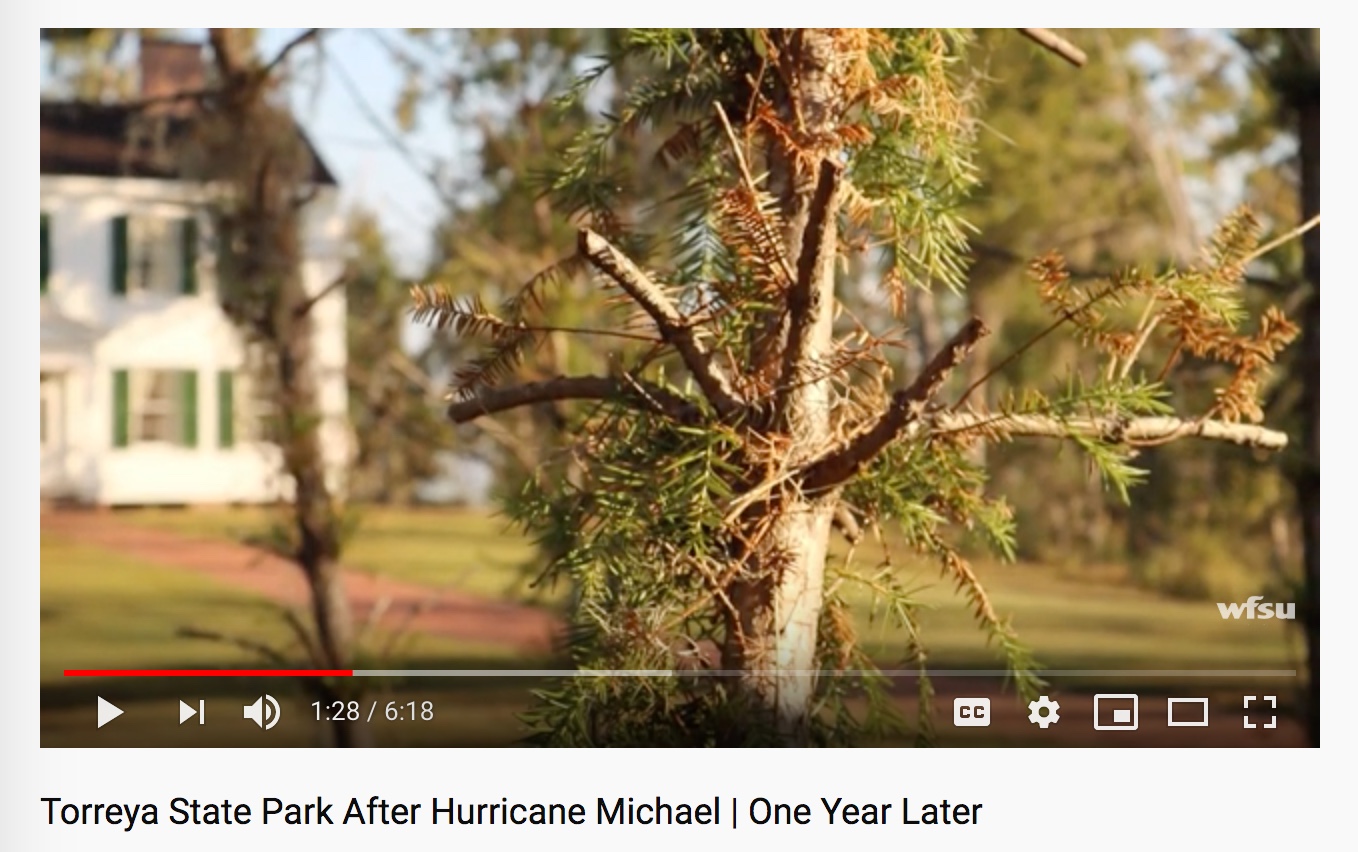
|
|
"In the 1950s, a fungal blight wiped out a population of about 600,000 Torreya taxifolia in the region. The Florida Park Service, Nature Conservancy, and the Atlanta Botanical Garden have been working to revive the Florida torreya, a species whose future may lie in its likely ancestral home of North Carolina, where planted trees have thrived disease free."
|
• August 2019 / Connie Barlow / 2018 paper ranks genus Torreya as both very rare and ancient

| |
Kevin M. Potter, Dept. Forestry and Environmental Resources of North Carolina State University, published a paper in the May 2018 online issue of the journal Biological Conservation:
"Do United States protected areas effectively conserve forest tree rarity and evolutionary distinctiveness?"
Connie Barlow added red type and arrows to the original figure, left.
Notice that the sister species in Florida and California of genus Torreya are among the rarest of 352 tree species native to North America.
These two Torreya species also are among the most ancient tree lineages.
Together, rarity and age of origin call out for the highest levels of conservation attention.
|
• May 2019 / Connie Barlow / New paper useful for understanding male/female flexibility in Torreya
During our site visit to the mature Florida Torreya trees in Louisiana, our guides recounted their experience with the largest specimen beginning as male and then starting to produce some female buds on various branches — culminating in seeds that fell and germinated beneath the parent tree. A 2019 paper on Striped Maple of eastern North America (a subcanopy species, just as is Torreya) can help us understand how to observe and possibly predict an individual's ability and propensity to begin producing seeds. Access full text.
EXCERPTS: "... Male-dominated sex ratios occurred consistently across study sites and the 4 years that sex expression was monitored. Approximately one-third of trees [studied as single branches cut and grown in a lab conditions] changed during any 2-year period. The five most common transitions were, in descending order of frequency: from non-reproductive to male, male to full or partial female flowering, female to dead, and from partial to full female flowering...."
 |
|
"... We have shown that in the sexually plastic tree Acer pensylvanicum a variety of factors influence expressed sex. Chief among them are previous sex and the health of an individual. Although the general theory regarding ESD in dioecious plants has indicated that females are often found in relatively better condition and at larger sizes, we find the opposite pattern in this species.... We show that mortality is disproportionately high in females...."
|
The Strange Mix of Vegetation Along the Apalachicola River


LEFT: hickory trunk in front of evergreen magnolia canopy, with trunk of American Beech at center.
RIGHT: Several shrubby palm species beneath a large beech in Florida's Torreya State Park, along the Apalachicola River. The botanical mix in the "steephead ravines" in this park is a treasure because the same site served, just 18,000 years ago, as a crucial "pocket reserve" in which the botanical richness of today's southern and central Appalachians took refuge at the peak of the last glacial advance.
|  |
|
VIDEO: "Glacial Stragglers": Here the Apalachicola is presented as a peak glacial refuge.
FLORIDA ANISE is featured as a species that didn't get very far north post-glacial (timecode 12:48).
FLORIDA YEW (13:50) and FLORIDA TORREYA (14:25) are featured as species that were entirely left behind. (Scientifically, "glacial relicts".)
Quote by Alex Eilts: "Ironically, they are now trapped in the same place that sheltered them in the past. But now as the the climate warms, their refuge — turned prison — may lead to their extinction."
|
Note: Mark Gelbart hypothesizes that Mastodons, rather than tortoises (or squirrels) were the dispersers of Torreya taxifolia during the Pleistocene. See also his blog contending that Torreya is missing its megafaunal disperser. In the latter blogpost, Gelbart draws from a 1978 book by Charles Wharton, The Natural Environments of Georgia, in which the Torreya's very limited habitat in Florida is described as "torreya ravines." Associated plants are listed:
"The dominant trees in a torreya ravine are red maple, southern sugar maple, beech, magnolia, basswood, elm, torreya, and sabal palm. Most of these species have northern affinities and are more commonly found in Appalachian cove forests. Other plants found in torreya ravines also represent species of northern affinities such as strawberry bush, hydrangea, and redbud. Wharton found torreya growing with beech, sourwood, and plum in the Faceville Ravine on the Flint River."
ASSOCIATED SPECIES: "Florida torreya is not included among the forest cover types established by the Society of American Foresters but is
commonly known to be among the oak-gum-cypress or oak-pine
types. In 1919, it made up about 4 percent of the forest along the
Apalachicola River. The most commonly associated species are
beech (Fagus grandifolia), yellow-poplar (Liriodendron
tulipifera), American holly (Ilex opaca), Florida maple (Acer
barbatum), loblolly pine (Pinus taeda), spruce pine (P. glabra),
white oak (Quercus alba), eastern hophornbeam (Ostrya
virginiana), and sweetgum (Liquidambar styraciflua). Shrubs and
lianas associated with Florida torreya are poison-ivy
(Toxicodendron radicans), greenbriar (Smilax spp.), crossvine
(Bignonia capreolata), yaupon (Ilex vomitoria), Florida yew
(Taxus floridana), blackberry and dewberry (Rubus spp.). Forbs,
grasses, and sedges include sedges (Carex spp.), panic grass
(Panicum spp.), partridgeberry (Mitchella repens), little sweet
Betsy (Trillium cuneatum), giant cane (Arundinaria gigantea),
and American climbing fern (Lygodium palmatum)." — Silvics Manual, Volume 1: Conifers (Click on Florida Torreya).
• VIDEO: Site Visits to Florida's Endangered Torreya and Yew Trees
 |
|
Connie Barlow presents 15 years of baseline photos and videos she recorded of Torreya taxifolia and Taxus floridana in their historically native range in Torreya State Park in northern Florida. Photos of spectacular California Torreya trees, recorded by Barlow in 2005, show the potential for Florida Torreya recovery efforts to strive for. Fred Bess shows (in 2014 video) 2 Asian conifers (Cephalotaxus and Cunninghamia) used in landscaping that are Torreya look-alikes. Paleoecological evidence that Florida's Torreya was "left behind" in its peak glacial refuge supports "assisted migration" actions. 63 minutes - assembled & published, January 2016 |
• Learn why T. tax is at the brink of EXTINCTION.
Classic Writings on Florida Torreya
In the spring of 1875, distinguished Harvard botanist Asa Gray embarked upon a trip to the panhandle of Florida, to "make a pious pilgrimage to the secluded native haunts of that rarest of trees, the Torreya taxifolia". The trees observed by Gray grew up to a meter in circumference and were as much as 20 meters tall.
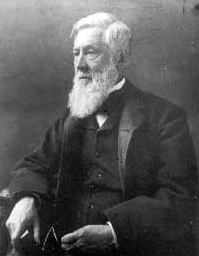 |

"... One young tree, brought or sent by Mr. Croom himself, has been kept alive at New York [Central Park] — showing its aptitude for a colder climate than that of which it is a native — and has been more or less multiplied by cuttings..."
|
EXCERPTS FROM "A PIOUS PILGRIMAGE":
"... The people of the district knew it by the name of 'Stinking Cedar' or 'Savine' — the unsavory adjective referring to a peculiar unpleasant smell which the wounded bark exhales. The timber is valued for fence-posts and the like, and is said to be as durable as red cedar. I may add that, in consequence of the stir we made about it, the people are learning to call it Torreya. They are proud of having a tree which, as they have rightly been told, grows nowhere else in the world...
"The largest [Torreya] tree I saw grew near the bottom of a deep ravine; its trunk just above the base measured almost four feet in circumference, and was proportionally tall. But it was dominated by the noblest Magnolia grandiflora I ever set eyes on, with trunk seven and a half feet in girth.... Seedlings and young trees are not uncommon, and some old stumps were sprouting from the base, in the manner of the California Redwood...."
"One young tree, brought or sent by Mr. Croom himself, has been kept alive at New York — showing its aptitude for a colder climate than that of which it is natve — and has been more or less multiplied by cuttings."
[Referring to] "the central and upper portions of Alabama and Georgia, where Torreya is unknown, but I fancy it may once have flourished. I cannot here detail the reasons for this supposition."
"Seedlings and young trees are not uncommon, and some old stumps were sprouting from the base, in the manner of Californian Redwood. So this species may be expected to endure, unless these bluffs should be wantonly deforested — against which their distance from the river and the steepness of the ground offer some protection. But any species of very restricted range may be said to hold its existence by a precarious tenure."
"Returning to the boat at nightfall, I brought with me thirty or forty seedling Torryas, which, being too far advanced to be safely sent far north this spring, have been successfully consigned to the excellent Mr. Berckman's care, at Augusta, Georgia. I hope that one or more of them may in due time be planted upon the grave of Torrey."
Editor's note: Dr. John Torrey, 1796-1873, is buried at Long Hill Cemetery, Stirling, Morris County, NJ Plot = SW corner (Presbyterian section) Memorial ID 8306740
A.W. Chapman's Torreya Experience, 1885
LEFT: Map published in 1885 of Torreya's native range, in report by A.W. Chapman
RIGHT: Map of 20th century range of Torreya taxifolia, from "Defining Indigenous Species: An Introduction" by Mark W. Schwartz, chapter in Assessment and Management of Plant Invasions, 1997.
Online access to Chapman's report in the April 1885 Botanical Gazette:
Torreya taxifolia "occupies a narrow strip of land extending along the east bank of the Apalachicola River from Chattahooche on the north to Alum Bluff on the south, a distance of about twenty miles, and forming a continuous forest, but in detached and often widely separated clumps or groves, generally mingled with, or overshadowed by, magnolia, oaks, and other native trees. . . It is a wild, hilly region, abounding in rocky cliffs and deep sandy ravines ("spring-heads") and unlike in scenery and vegetation any other part of the low country known to me. To these cliffs, and to the precipitous sides of the ravines, the tree appears to be exclusively confined; for it is never seen in the low ground along the river, nor on the elevated plateau east of it, nor, indeed, on level ground anywhere. Hence, although the suggestion may appear a startling one, were the trees of the whole region growing side by side in one body, I estimate that an area of a few hundred acres would suffice to contain all of them.
... But its chief value is due to the remarkable durability of its
wood when exposed to the vicissitudes of climate; for it is credibly reported that some fences constructed of it sixty years ago still remain in sound condition. In consequence of this peculiarity it is now extensively employed by the inhabitants of the surrounding country for posts, shingles, and other exposed constructions. In view of these facts, the future of our Torreya is a matter calculated to excite very grave apprehensions. A tree possessed of such valuable qualities, occupying an area so limited
in extent, and in the midst of a population where the old rule of "Let him take who has the power, And let him keep who can" has unlimited sway, is destined, it is to be feared, to ultimate extinction.
Let us indulge the hope that the interest which is beginning to be manifested in regard to the preservation of our forests generally, may result in measures statutory or otherwise for its preservation.
1890 Editorial Reports Common Name Switch to Torrey-Tree
MAY 7, 1890 issue of Garden and Forest, page 222 excerpt:
"...Trees, which are usually of importance to man or sufficiently conspicuous to attract his attention, obtain naturally local vernacular names before science imposes others on them, and the common names once engrafted on a language, almost always hold their own among the people of the country where the trees are found. It was a matter, therefore, of much interest and some surprise to hear recently, in western Florida, the Torreya taxifolia, one of the rarest of all our trees, spoken of generally as the 'Torrey-tree'; and to find that Stinking Cedar, the unattractive name by which this tree was first known to the inhabitants of western Florida, was gradually being replaced by that of one of the Nestors of American botany.
The reason for this change is found perhaps in the fact that this tree, from its rarity, the interest attached to the geographical distribution of the small genus to which it belongs, and the reverence which his successors have always felt for the name of John Torrey, has several times been visited in its remote and isolated stations on the banks of the Appalachicola by men of science from distant parts of the country. When the people of the region, therefore, found that men of mature years and apparently in the enjoyment of all their faculties had journeyed thousands of miles merely to look at a tree which they had always considered as valuable only because it furnished indestructible material for fence posts, their own interest and curiosity became aroused; and therefore hearing these eccentric strangers talking always about Torrey and Torreya, the name has gradually become fixed, and now 'Torrey-tree' may often be heard in at least two or three counties of west Florida."
EDITOR'S NOTE: This 1905 publication contains the first suggestion that Torreya's preferred habitat lies northward of its endemic Florida range. Access online the entire report. Note that the author posits that:
"It is associated with a remarkable and somewhat extensive group of northern mesophytic plants, and the conclusion is irresistible that Torreya is a northern plant of the most pronounced mesophytic tendencies, and to be associated with such forms as the beech-maple-hemlock forms of our northern woods, our most mesophytic type of association."
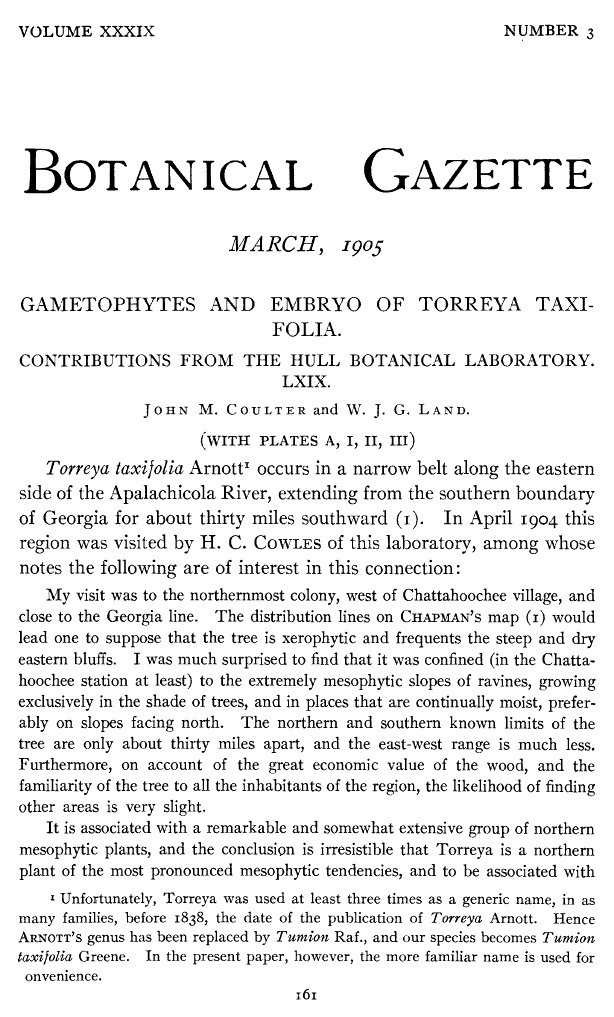
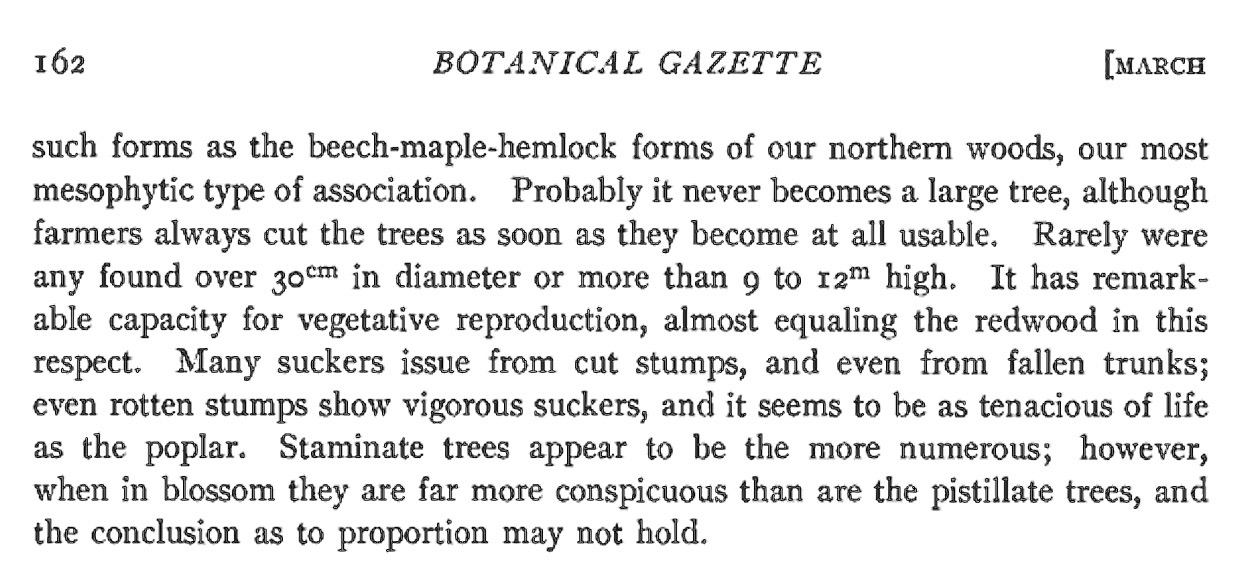
 |
|
"A Remarkable Colony of Northern Plants Along the Apalachicola River, Florida, and Its Significance"
by H. C. Cowles, 1905
Report of the Eighth International Geographic Congress
Held in the United States
KEY SECTION:
In this association one finds two of our most notable endemic plants — Torreya and Croomia. It seems likely, then that we should regard Torreya taxifolia as a northern mesophytic left stranded to-day only in Florida.
It presumably is one of the plants that failed to follow up the last retreat of the Pleistocene ice, and is preserved here perhaps because of exceptionally favorable topographic conditions.
|
• 1926: Frank Thone contributed a short section on "The Apalachicola River endemics" in the 1926 edition of Naturalist's Guide to the Americas:
"There is a colony of Torreya taxifolia, together with a number of other endemic and disjunct species along the bluffs of the Apalachicola River between Chattahoochee and Bristol. Are well drained, but at the same time thoroughly moist, because of the abundant seepage water and the low evaporation rates that prevail. Magnolia occurs among the trees, and scrub palmettos in the undergrowth are plentiful. Torreya grows all over the slopes of the ravines, from stream-bank to rim, wherever there is any shade. It is mostly an undergrowth tree, seldom reaching a height of more than 20 or 25 ft. or a trunk diameter of more than 6 in."
• Herman Kurz wrote in 1938, Proceedings of the Florida Academy of Sciences, volume 3, "Torreya West of the Apalachicola River":
"In past geological times Torreya was more or less widespread throughout the Northern Hemisphere, but from the heart of this area the species vanished in geological times. The genus, because of its once greater past, its subsequent decline, and its final local last stands, has always fascinated naturalists. Today only remnant areas with four well established relic species remain: Torreya californica in the mountains of California; Torreya taxifolia in the Apalachicola River vicinity of Florida and extending a mile or so into Georgia; Torreya grandis in central and northern China according to Sargent and in eastern China according to Rehder; and Torreya nucifera ..."
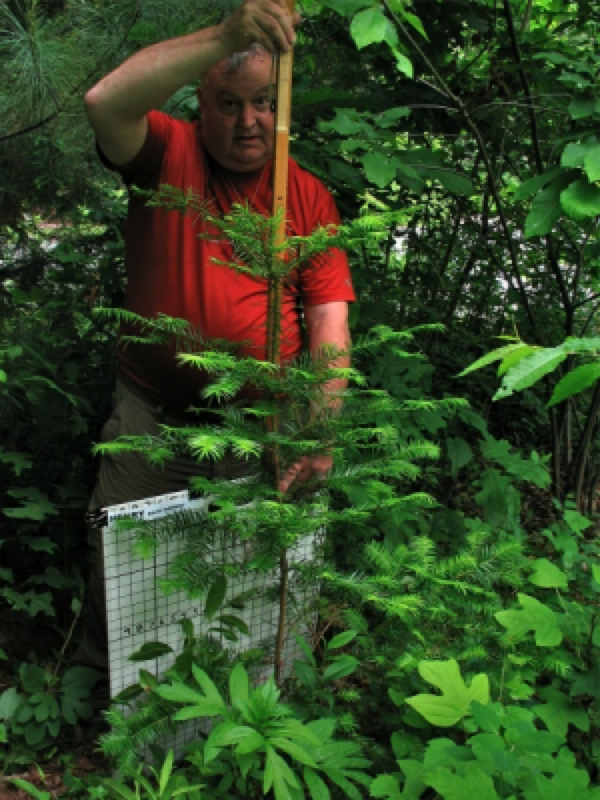 |
|
Lee Barnes, one of the founding Torreya Guardians (and a native North Carolinian), measures the growth of "Thoreau" T. taxifolia tree, four years after it was planted at Corneille Bryan Native Plant Garden, in Junaluska NC. (photo by Connie Barlow, May 2012). In spring of 2014, Lee rediscovered in his archives a paper he wrote for a graduate course in horticultural science in 1983. You can access a pdf of that paper: "Morphology of Torreya taxifolia".
In 2013, Torreya Guardians began trying to learn how best to encourage symbiotic fungi (mycorrhizae) to grow amidst Torreya's roots in our plantings, so Lee's 1983 observation is prescient: "Seedlings produce extensive root systems before much top growth. Also, numerous individuals have noted that Torreya spp. grow naturally slow. It has also been observed that many species with thick roots grow slowly unless inoculated with mycorrhizae. Currently, investigations are underway to determine if mycorrhizal inoculation will increase the growth rate of rooted cuttings and micropropagated plants." (p. 12)
Note: Four unpublished papers by Lee Barnes and his doctoral dissertation are in the "Literature cited" list of the 1986 "Florida Torreya Recovery Plan.
|
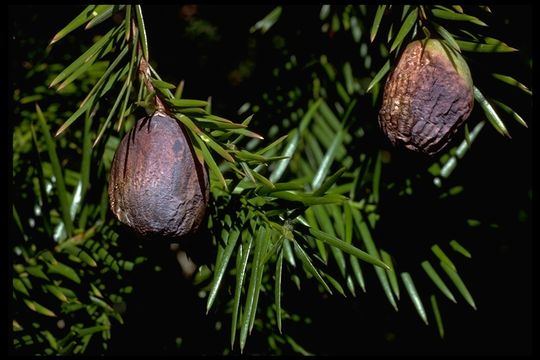 |
|
Genus Torreya in online Encyclopedia of Life
The Encyclopedia of Life online has a lot of photos of genus Torreya — especially the one Californian and several Asian native species. For example, the photo left of ripe seeds of California Torreya confirms that this sister species has the same seed shape and color as Torreya Guardians have documented of North Carolina plantings of the Florida Torreya. (If you click on the "original" link associated with each photo, you will sometimes find not only the original photo but detailed information on date and place.)
|
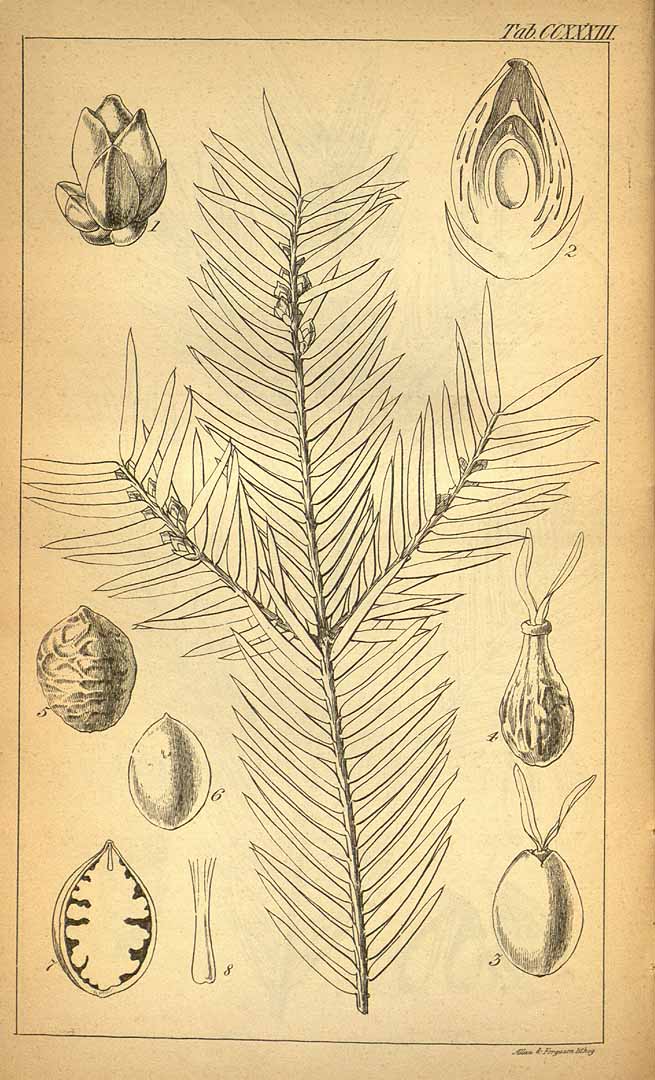 |
 |
|
ABOVE: Click on images for links to these Torreya taxifolia archive pages of Hooker's Icones Plantarum, 1840.
In 2020 the New York Botanical Garden reported archival research in collating the communications between Croom and Torrey on the initial botanical recognition in Florida of this species as a new-to-science genus. Clips of the correspondence appear in this very helpful report: "The Case of the Florida Nutmeg: Empowering Research on Endangered Plants", by Grace Constantino.
• "Environmental Status of the Stinking Cedar, Torreya taxifolia", by Richard Stalter and Steve Dial, 1984, Bartonia 50: 40-42.
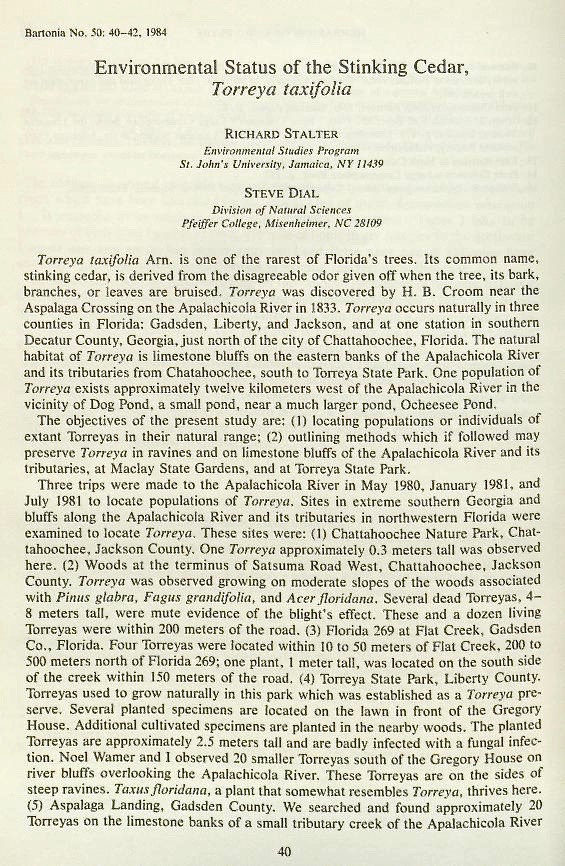
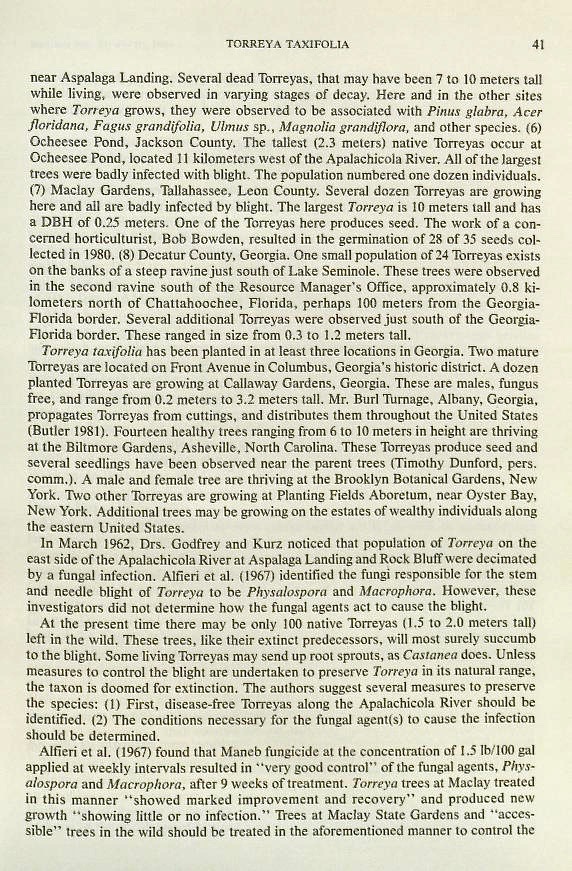
• Annual Report of the Commissioner of Agriculture 1884, Report of the Botanist, Geo. Vasey, pp. 126-27. Included within this section is a report by A. H. Curtis of field trip findings.
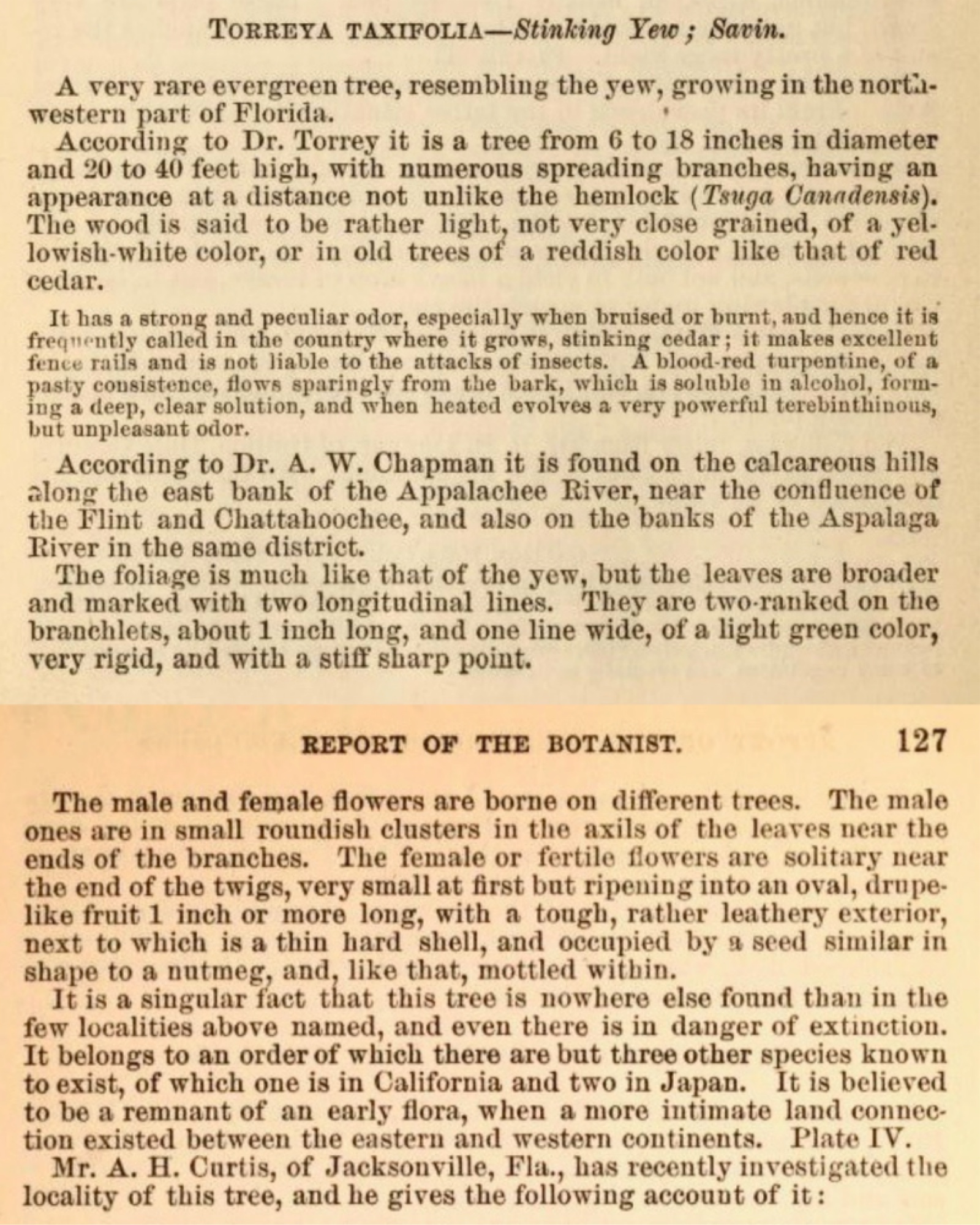
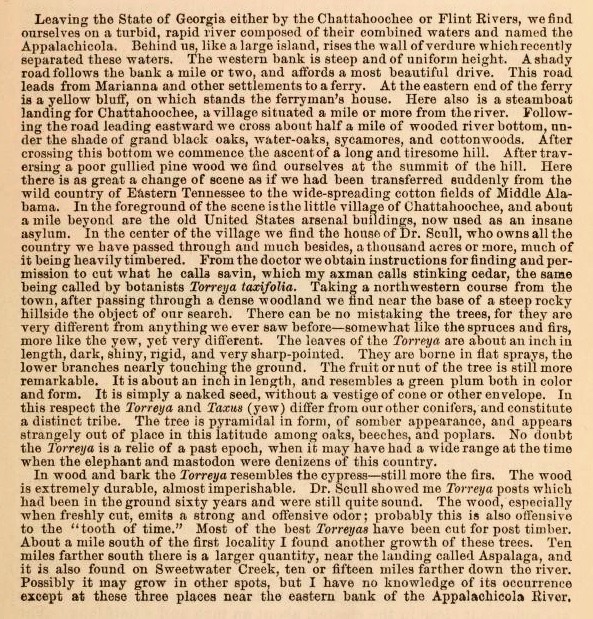
• 1890 ATTEMPT TO REPLACE COMMON NAME "STINKING CEDAR" WITH "TORREY TREE"
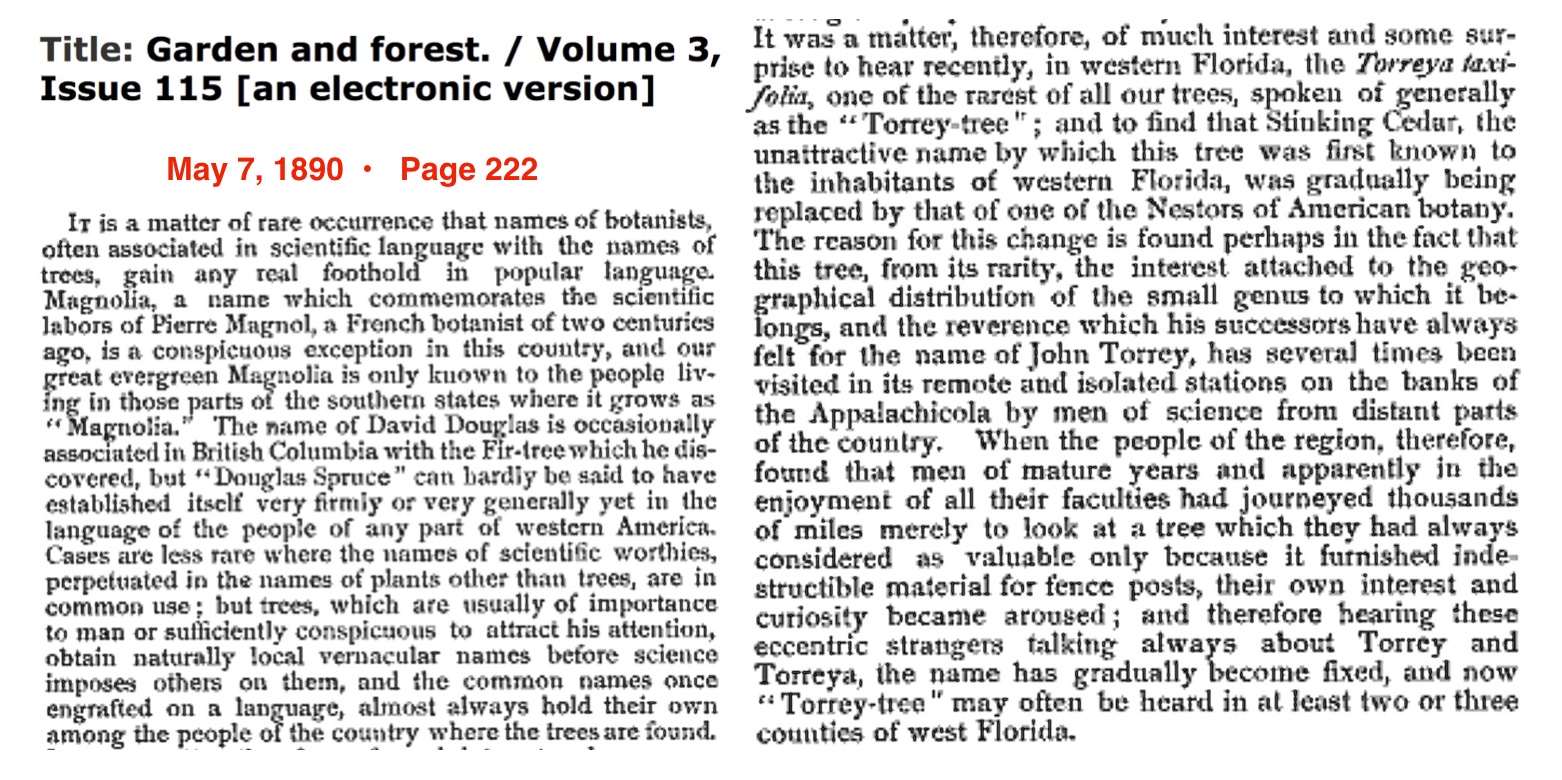
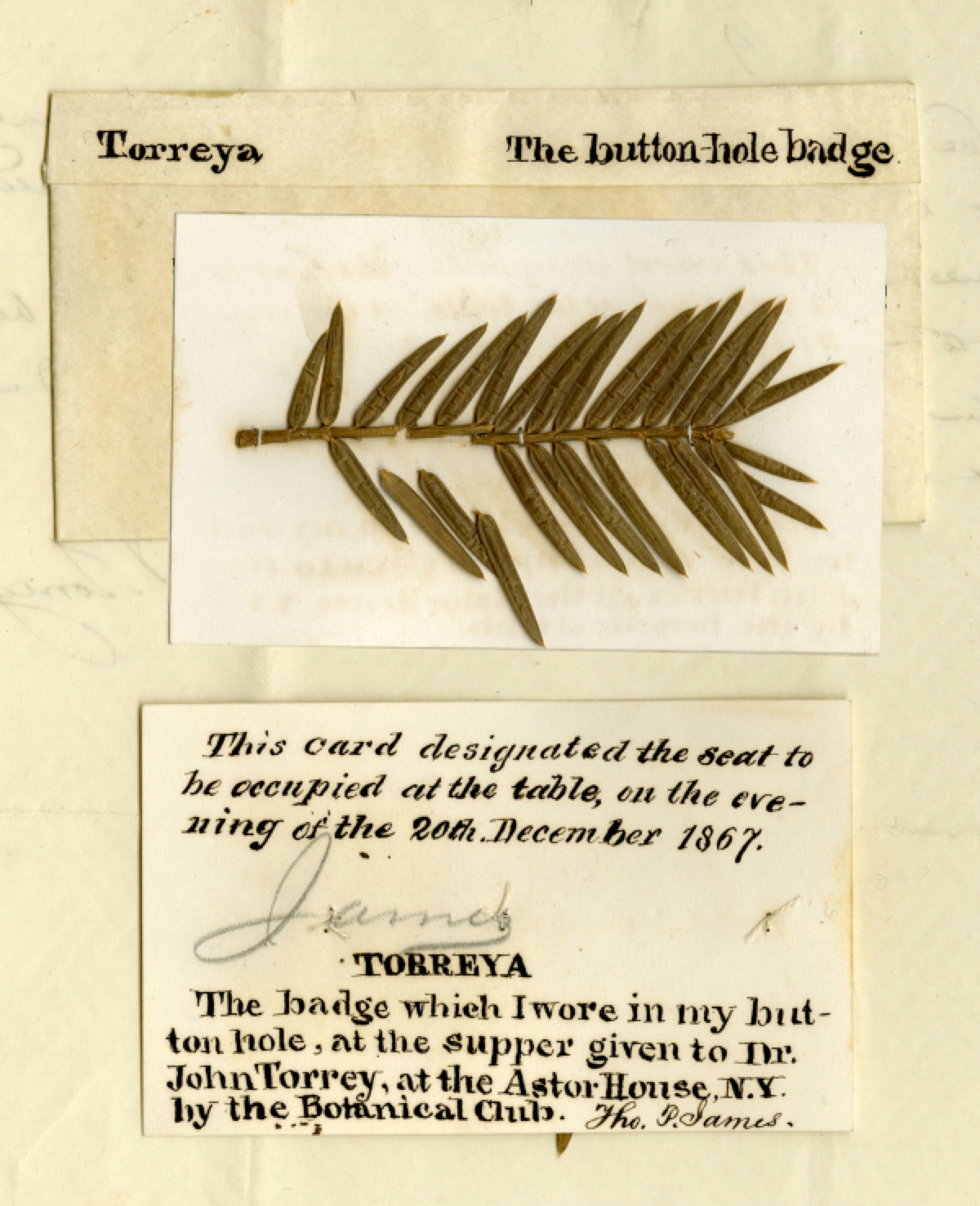 |
|
"John Torrey: A Biographical Notice by Asa Gray American Journal of Science and Arts
1873.
EXCERPT ON DISCOVERIES OF 4 TORREYA SPECIES:
"... Almost in his youth a genus was dedicated to him by his correspondent, Sprengel: this proved to be a Clerodendron, misunderstood. A second, proposed by Rafinesque, was founded on an artificial dismemberment of Cyperus. The ground was clear, therefore, when, thirty or forty years ago, a new and remarkable evergreen tree was discovered in our own Southern States, which it was at once determined should bear Dr. Torrey's name. More recently a congener was found in the noble forests of California. Another species had already been recognized in Japan, and lately a fourth in the mountains of Northern China. All four of them have been introduced and are greatly prized as ornamental trees in Europe. So that, all round the world, Torreya taxifolia, Torreya California, Torreya nucifera, and Torreya grandis — as well as his own important contributions to botany, of which they are a memorial — should keep our associate's memory as green as their own perpetual verdure."
______
IMAGE LEFT APPEARS ON THIS SAME DIGITAL PAGE OF THE HARVARD ARCHIVE (above).
|
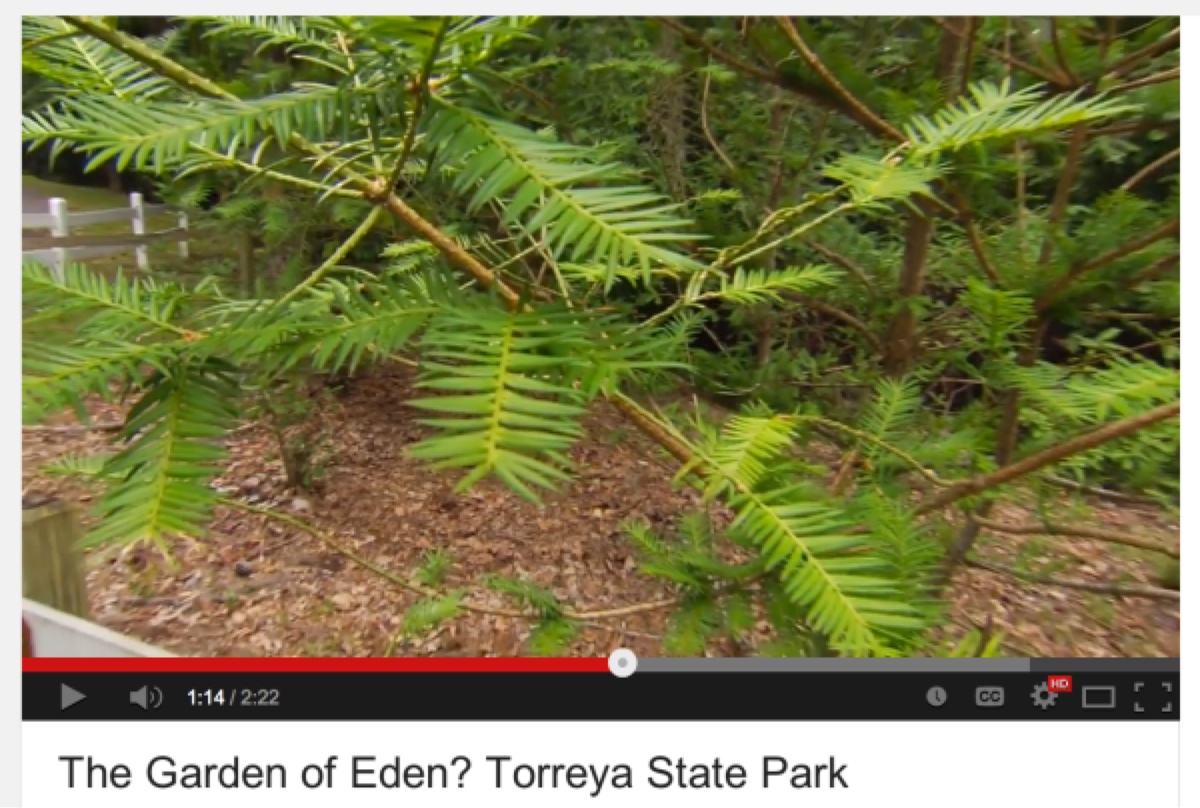
Click above for a 2-minute video of Torreya State Park in n. Florida.
• 1983 paper with map of inventory of Florida Torreya wild populations in southern-most Georgia: "A Georgia Station for Torreya Taxifolia arn. Survives", by Thomas Savage, 1983, Florida Scientist.
Contact Connie Barlow OR
Contact Fred Bess
Return to HOME PAGE
Annotated List of Papers/Reports Online re Assisted Migration